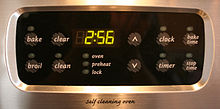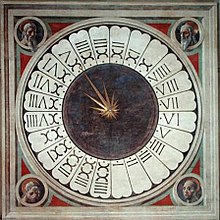Agogo
Agogo jẹ́ ohun èlò tí a ń lò láti ṣòdiwọ̀n iye wákàtí tí wà nínú ọjọ́ kan ṣoṣo, and indicate time.Agogo jẹ́ ọ̀kan pàtàkì nínú ìmọ̀ ìjìnlẹ̀ tí ọmọnìyàn ṣe àwárí rẹ̀ láyé. Ó jẹ́ ọ̀kan lára ohun tí a fi ń ṣe ònkà ọjọ́, oṣù àti ọdún.[1][2][3][4]




Nínú ìmọ̀ nipa aago, ohun tí wọ́n gbà wípé agogo ni aago tí ó bá dún gbagaun, nígbà tí wọ́n pe èyí tí kìí dún ní kajọ́. [5] Láyé òde òní, agogo ni ohun tí a mọ̀ tí ó ń ṣàfihàn ònkà ọjọ́. Agogo lè jẹ́ èyí tí a fi kọ́ sí ara ògiri ililé tàbí èyí tí a so mọ́ ọrùn ọwọ́ wa láti lè ma fi mọ ònkà àti àsìkò inú ọjọ́.[6]
Àwọn Ìtọ́ka sí
àtúnṣe- ↑ Dohrn-van Rossum, Gerhard (1996). History of the Hour: Clocks and Modern Temporal Orders. Univ. of Chicago Press. ISBN 978-0-226-15511-1. https://books.google.com/?id=xYhlNoUu-toC&dq=verge+escapement+technology., pp. 103–104
- ↑ Marrison, Warren (1948). "The Evolution of the Quartz Crystal Clock". Bell System Technical Journal 27 (3): 510–588. doi:10.1002/j.1538-7305.1948.tb01343.x. Archived from the original on November 10, 2014. https://web.archive.org/web/20141110143908/http://timepieceperfection.com/THE-BELL-SYSTEM.pdf. Retrieved 10 November 2014.
- ↑ Cipolla, Carlo M. (2004). Clocks and Culture, 1300 to 1700. W.W. Norton & Co.. ISBN 978-0-393-32443-3. https://books.google.com/?id=YSf9MVxa2JEC&pg=PA31&dq=verge+escapement+technology., p. 31
- ↑ White, Lynn, Jr. (1962). Medieval Technology and Social Change. UK: Oxford Univ. Press. pp. 119.
- ↑ see Baillie et al., p. 307; Palmer, p. 19; Zea & Cheney, p. 172
- ↑ "Cambridge Advanced Learner's Dictionary". Retrieved 2018-01-29.
a device for measuring and showing time, which is usually found in or on a building and is not worn by a person